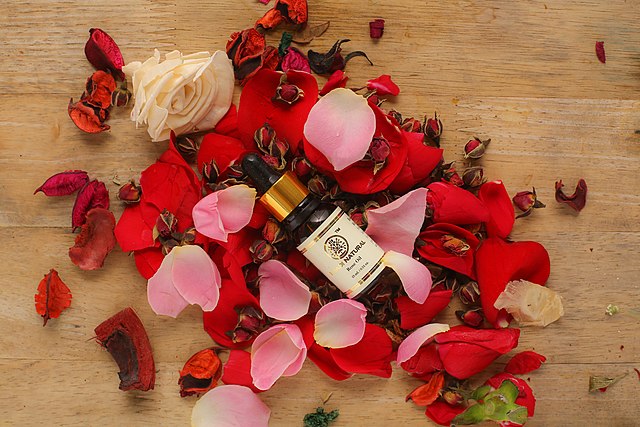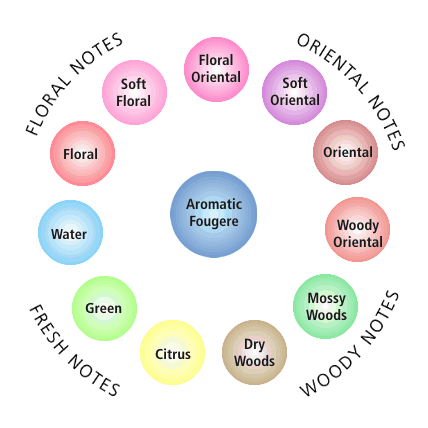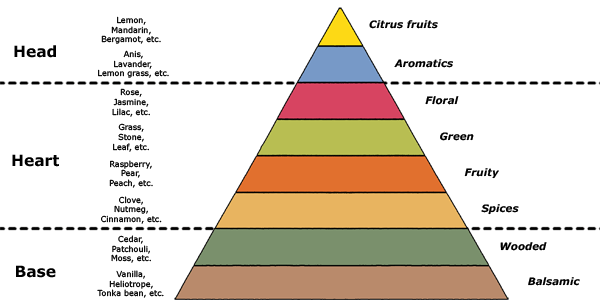We’re at Part 4 in this series –thanks for still reading!! I’m squeezing three different bits of this topic into today’s post. Each one could be a post and covered in so much more detail, but they sort of go together. Bear with me?

MIXING SCENTS
The best perfumes are achieved by combining scents. But how do you know which goes well with which? This is where real artistry, a sensitive nose, and the value of treasured recipes come into the process. Part of the challenge of mixing scents is the very subjective nature of how different people perceive them and the difficulty in categorizing them, something still being studied.

The “fragrance wheel” (aka aroma, perfume or smell wheel or fragrance circle) was invented by an Austrian perfumer and published in 1949 to show the families of smells and their relationship to each other. The concept has undergone multiple revisions since then as science and perfumers have added to our knowledge. But combinations of scents must account not only for the blend of odors, but also how and when the scents in the mix reveal themselves.
Among the many terms in perfumery are the concepts of “top/head”, “middle/heart” and “bottom/base” notes, which refer to the differences. Top notes are lighter and usually are the first impression, which may evaporate in as little as 15 minutes. Middle notes can take some time to develop, but then usually last for a while, giving the perfume its primary identification. Base notes are the longest lasting, often acting as a fixative to prolong the overall effect of the other scents.

The “fragrance pyramid” tries to capture these qualities. Some fragrance wheels try to incorporate these characteristics along with the descriptive categories and can become very complex. You can find many different ones online. I particularly like the one here. But these are modern measures. In the Regency, making perfumes was still more art than science.
Keeping track of combinations that worked well was important. Perfumery as an art goes back at least 5,000 years to the ancient Egyptians, but the first-known written record dates to 1200 BCE in Mesopotamia. Indians, Persians, Arabs and Romans all left written records about making perfumes. The first “modern” perfume, meaning essential oils dissolved in alcohol, was developed in 1370 for the Queen of Hungary. So-called Hungary Water became known across Europe but supposedly the recipe was lost (although the 1784 Toilet of Flora mentions it as a remedy to both cleanse and strengthen the body, made from rosemary, pennyroyal and marjoram flowers mixed with conic brandy.
Remember Floris, where this series began? Nearly three centuries of custom-blended formulas are recorded in ledgers stored carefully and still kept strictly secret. Our heroine’s family recipe for the scent she is making in her stillroom (be it personal perfume, smelling salts, or scent for soap) might have been handed down through many generations and could be a family secret. I mentioned Princess Esterhazy’s perfume in Part 3, after discovering this entry in E. Rimmel’s 1867 book on perfumery which calls “Bouquet d’Esterhazy” “an old renowned perfume, a rival of Cologne water; the name derived from a noble Hungarian family.” Two quite different formulas, one French and one German, are given for it.
Household recipe books in the Regency might include perfumes as medicinal remedies, beauty aids or grooming products. Despite the Toilet of Flora’s claim to be “for the ladies”, the separation of particular perfumes into distinct categories as well as the idea of identifying them as male or female was only just beginning in the first quarter of the 19th century.

SCENTS FOR THE SEXES
In Part 3 I mentioned Napoleon’s bathing in Eau de Cologne by the gallon. (Apparently he also drank it.) Wikipedia says that he used “Two quarts of violet cologne…each week, and…sixty bottles of double extract of jasmine every month.” You might think that his use of what some consider “feminine” fragrances was eccentric (or simply French), but you would be wrong. During the Regency, barbers might just as easily have used a rose pomade on a man’s hair or a jasmine scented shaving lotion as one with a more “masculine” woody or spice scent.
Interestingly, Napoleon’s wife Josephine was said to have favored musk, a very strong scent, one used often as a base note and fixative in modern men’s scents. The same Wikipedia article says “she used so much that sixty years after her death the scent still lingered in her boudoir.” Other sources say she also liked to use vanilla, woody scents, and imported patchouli and tonka bean (fragrances not now considered as feminine as floral scents would be.) Patchouli (a woody herb in the mint family that smells “musky-sweet”) was also used by the Indian exporters of fine cashmere shawls to scent their products. I read an account of a French maker of imitation shawls who went to great lengths to obtain the scent to make his shawls seem more authentic. (Muslins, too, were scented with a special characteristic sachet powders).

As with so many other things in the transitional 19th century, assigning gender identity to different scents really sharpened when the large scale commercial production of perfumes and the discovery of synthetics increased the availability of perfumes and inspired marketers to promote the concept. It’s “modern” and also mostly just in Western culture. The fact that our Regency characters could wear any scent they liked free of gender associations presents one of those conundrums we writers run into from time to time—the conflict between what is accurate to the period and what is acceptable to our readers.
If we present our manly romance hero smelling like jasmine or violets, what does that do to his masculine image for the uninitiated reader? Certainly we can solve it by swathing him in the scents of cedar wood and cloves on the basis of his personal preference, but I do wonder if the lack of any specifically “men’s” scents in the Regency period might have led to the controversial use of Bay Rum by heroes in some of our books?
I have a theory, and won’t mind at all if I am proven wrong, but I just wonder if the idea of Bay Rum for Regency heroes might have started with Georgette Heyer. Does anyone know? I think I used it in one of my early books, and know I’ve read it in others. It sounds rather manly, doesn’t it? It did become popular in the 19th century and was still very popular for men when GH was writing, so the theory doesn’t seem crazy.

THE TRUTH ABOUT BAY RUM
The truth about Bay Rum is more complicated than you might think. The reason is simple: bay tree (aka bay berry tree) leaves were used for a variety of purposes for centuries by native West Indies people without any particular written record. (note this is not the same leaf or plant as the bay leaves used in European cooking). Islanders used the leaves as an aromatic, fumigant, and insect repellent, hanging branches in their homes or burning the leaves to drive away mosquitoes. They used it as an emollient sponged on the skin to fight fevers or pain, but also to heal cuts or bruises, as the oil has anti-fungal and anti-bacterial properties besides being soothing and refreshing. They believed it could stimulate hair growth and fight dandruff. Slaves and pirates rubbed the leaves on their skin to heal sunburn and in close living quarters to fight body odors from long hours of hard work under a hot sun.
Bay rum smells so good it has been touted as an anti-depressant, creating a sense of well-being and confidence. Scents commonly identified with it include cinnamon, clove, allspice, oak, sweet vanilla, eucalyptus, musk, and other spices.
No one knows for certain when or by whom the leaves were first soaked in rum to extract and liquefy the oils and prolong the scent, but production of “Rumbullion, alias Kill-Divil” in the West Indies dates to the early 17th century. Was it rum-swilling pirates as some theorize? Native islanders? Or slaves whose labor produced the rum? At any rate, it seems likely that a basic form of bay rum was known and in use in the islands soon after. No one knows when other ingredients such as lime or spices were first added, either. Certainly, the British were intimately involved with slavery and trade in the West Indies, so the local cure-all must have been known to them.

Does this mean your Regency hero can wear Bay Rum? Probably not (unless he’s a pirate, or…). Given the mindset of most 19th century British men, the fact that the local people or the slaves used it might automatically taint it as unfit/unfashionable for their own use. I suspect supply was also an issue, as it was most likely only produced within households for the locals’ own use. It was not available commercially.
That only changed sometime after 1838, when a Danish chemist (Albert Heinrich Riise) in the islands began exploring the distillation process and refined the technique and recipe for producing bay rum as a standardized, diluted commercial product. (On this basis some sources claim he “invented” it.) He started selling it under the name A.H. Riise Apothecary, primarily as a cologne/after-shave and manufactured in large quantities. How long this took is not clear, but by 1861 bay rum was well-known in the U.S. but still little-known in Europe, according to an article about it in the American Journal of Pharmacy. That Riise won awards for it (the Centennial Medal in 1876, plus awards in New Orleans and Chicago) can’t be disputed. Nor can the fact that it gained a foothold in Britain at about that time, and became a standard offered in barbershops in the late Victorian era and into the early 20th century. As mentioned, very popular at the time Georgette Heyer was writing. It is still sold today by quite a few companies.
We’ve one more important aspect about this topic I didn’t want to skip—the amazing bottles used to hold and store the perfumes. I’ll be posting about that in Part 5 on June 14. I’ll include a list of more sources, too, but here are a few I recommend:
An excellent and comprehensive source for more information about scent and perfumes is: https://perfumepower.co.za/wp-content/uploads/2018/06/Perfume_Power-Ebook.pdf
For more about essential oils and aromatherapy (also a great fragrance wheel), try: https://www.sacredsoulholistics.co.uk
For more about the classification of different scents and their qualities, try: https://beautyjunkiejax.com/fragrance-classification/
Or this site, which has posts about individual scent ingredients as well as interesting history notes by each century.
Note: all images without attribution in this post are sourced from public domain through Wikimedia Commons.
Did you learn something you didn’t already know in today’s post? Have any answers to my questions? I invite you to leave a comment! Thanks for reading!

